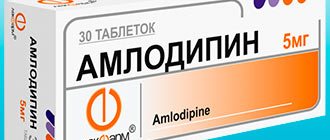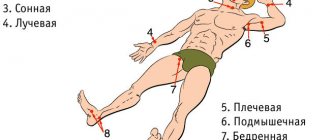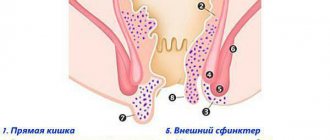Causes of headaches and numbness in hands
For headaches that are accompanied by numbness in the hands, it is important to make a timely diagnosis and determine the cause of these symptoms. They can be triggered by various factors, including poor circulation, low blood pressure and others. In addition, a sharp deterioration in health indicates the development of a stroke, rehabilitation for which is most effective when seeking medical help within the first two hours after the attack.
Stroke
Main article: Stroke
A stroke is an acute disruption of the blood supply to the brain. As a result of oxygen starvation, necrosis (death) of certain areas occurs, which is accompanied by disruption of nervous activity. Typical signs of a stroke are loss of consciousness, headaches, asymmetrical work of the muscles of the face and body, memory loss and deterioration of mental activity. These symptoms are individual for each patient and depend on the size and exact location of the affected area.
A stroke can occur without obvious symptoms, but cause long-term consequences and pose a danger to the patient’s life. To identify it in the early stages, there are several tests that can be performed at home:
- Face – when trying to smile, the corners of a person’s mouth rise unevenly;
- Hands - the victim will not be able to hold both hands in front of him for 10 seconds, one hand will fall down;
- Speech – speech becomes unintelligible, difficulties arise when trying to repeat a simple sentence;
- Time is a warning that if at least one symptom is present, a person’s life is in danger, and it is important to get to the hospital as quickly as possible.
Risk factors for stroke include old age, bad habits, excess weight, sedentary lifestyle, as well as chronic heart and vascular diseases. Thus, atherosclerosis is vascular damage that occurs due to the deposition of cholesterol and lipoproteins on the walls of the arteries. An unhealthy diet high in animal fats can cause deterioration in the elasticity of blood vessels and cause a stroke. Smoking and alcohol abuse are factors that also affect the intensity of blood supply to the brain. However, a stroke can be a consequence of hidden pathologies or occur suddenly in a young person with a healthy cardiovascular system.
Diseases of the neck and spine
Main article: Headache and neck pain
Neurological symptoms and headaches can also result from compression of the nerves in the cervical spine. Thus, the nerves of the cervical plexus innervate the occipital part of the head, so their damage will be accompanied by acute pain. Also in this area, nerves originate that carry impulses to the upper limbs. Headaches, numbness of the hands - these are a typical picture for a number of diseases:
- Osteochondrosis of the cervical spine (Main article: Headache with osteochondrosis of the cervical spine) is a chronic process in which there is a slow destruction of intervertebral cartilage. They become less elastic, thinner, and therefore cannot fully absorb shock during movement. This leads to insufficient mobility of the neck, pain, and a decrease in the clearance between the vertebrae. Bone segments compress blood vessels and nerves, which is accompanied by a deterioration in nerve conduction and blood circulation.
- Protrusion is a protrusion of the intervertebral disc on one side. Normally, it follows the shape of the vertebrae, but can be displaced as a result of injuries, weakness of the spinal ligaments, as well as uneven pressure on the vertebrae on both sides. Protrusions are treated with special gymnastics, massage, swimming, taking painkillers and muscle relaxants, and you may need to wear a collar. The disease progresses, and over time, if left untreated, progresses to the following stages. The last of them is intervertebral hernia, in which the dense fibrous membrane of the cartilage ruptures.
- Injuries and their consequences pose a danger to the health and life of the patient. Fractures of the vertebral bodies and processes, ruptures of ligaments lead to acute pain and require long-term rehabilitation. In the future, inactivity may persist in certain areas, increasing the risk of developing osteochondrosis and other chronic diseases.
Diseases of the cervical spine require long-term treatment. Its effectiveness will depend on regular exercise at home, as well as on compliance with other doctor’s recommendations. It is important to understand that in case of osteochondrosis, protrusions and hernias, it is necessary to monitor your posture throughout the day, dosage physical activity, and also not endure pain and attacks of numbness in the hands - with these disorders it is always worth making an appointment with a doctor for examination.
Diseases of the heart and blood vessels
Diseases of the cardiovascular system also lead to headaches, numbness in the hands and other alarming symptoms. They can occur in acute and chronic forms, be congenital and acquired. Thus, congenital heart defects, structural anomalies of valves and large vessels are accompanied by deterioration of blood circulation at any age. However, acquired disorders are more often diagnosed:
- Hypotension (See: Headache with low blood pressure) is a chronic decrease in blood pressure. Blood spreads slowly throughout the body, so the speed of blood flow in the upper extremities and head is significantly reduced. This leads to hypoxia (oxygen starvation) of tissues and deterioration of their innervation. For hypotension, complex treatment aimed at increasing blood pressure is prescribed.
- Atherosclerosis (See: Headache as a symptom of atherosclerosis) is a metabolic disorder in which deposits of cholesterol and lipoproteins appear on the inner walls of the arteries. These substances narrow the lumen of blood vessels, thereby impeding blood flow. In the future, they can form plaques and completely block the arteries, posing a danger to the patient’s life. Circulatory disorders are diagnosed using vascular ultrasound with the addition of a contrast agent. This allows you to determine the exact location of the damaged area and make a diagnosis. As treatment, a diet low in fat and cholesterol is prescribed, as well as drugs that stimulate its elimination.
- Aneurysm is a pathological expansion of a section of blood vessels (usually arteries) with the formation of a pocket filled with blood. At the same time, their walls become significantly thinner, and there is a risk of their rupture, especially with increased pressure. In the presence of an aneurysm, neurological symptoms, frequent headaches, and numbness of the hands occur. It is important for patients to monitor their well-being; according to the doctor’s decision, a planned operation is performed to restore the damaged area of the vessel.
Chronic diseases of the heart and blood vessels, if left untreated, can cause a stroke. Thus, narrowing of the lumen of the arteries and hypotension are provoking factors for the development of ischemic stroke, which occurs during prolonged hypoxia of parts of the brain. An increase in pressure to critical levels can provoke a hemorrhagic stroke - it occurs when a vessel ruptures and is accompanied by cerebral hemorrhage. According to statistics, hemorrhagic stroke is more life-threatening, and rehabilitation in this case is less effective, but the prognosis is determined individually, depending on the degree of damage and the exact area of the brain.
Cardiac causes of pain radiating to the left arm
Typically, this type of pain appears when there are problems with blood flow. It occurs especially often after physical or emotional stress. Sometimes the symptom worsens and emergency medical attention is required. Therefore, it is important to understand its character in order to prevent the development of complications.
Ischemic disease is a key cause
Cardiac ischemia is a disorder that combines several ailments that differ in the damage to the myocardium. Of these, there are 2 main diseases:
- Angina is a disease characterized by discomfort in the chest. Occurs after physical exertion or emotional stress. The pain radiates to the left arm, part of the neck and jaw. The patient's heart aches, and as the pain increases, he experiences a strong fear of impending death.
Important! A distinctive feature of an angina attack is that its duration is about 10 minutes. It is recommended to take a Nitroglycerin tablet or completely calm down and relax, then it will stop on its own.
To prevent this situation, doctors recommend taking medications that strengthen and restore the main muscle.
- Myocardial infarction. The disease occurs against the background of obstruction of the lumen of the vessel, which causes a sharp deficiency of nutrients that enter the heart with blood. This spasm causes the death of certain areas of the heart muscle. The person feels a burning sensation, severe pain in the chest, and the left side of the body suffers. Manifestations of the disease are not controlled by vasodilators, and symptoms increase. The patient must be urgently hospitalized for medical care.
Silent myocarditis
One of the causes of chest pain is inflammation of the heart muscle. Pathology stimulates a violation of its excitability, conductivity and contractility. Typical signs are observed 10 days after the onset of the disease. The patient complains of sensations such as:
- It aches and hurts inside.
- The pain radiates to the left side of the shoulder girdle, pulling.
- Severe weakness, weakness.
- Increased sweating.
- During body movement, unpleasant sensations intensify, making breathing difficult.
- Sometimes body temperature changes.
- Night sleep is disturbed.
- There are interruptions in the heart rhythm.
Important! All manifestations of the disease occur at a time of rest.
The first signal of the onset of changes is asthenia. The patient most often does not pay attention to this and only on the 7th day, when typical signs occur, does he consult a doctor. Unfortunately, during this time the disease enters a severe stage; the patient requires long-term treatment and rehabilitation.
Diagnostic methods
In case of headaches, numbness of the fingers or upper extremities, a completely timely diagnosis is very important - it can improve prognoses in the event of a stroke and other dangerous lesions. Depending on the results of the examination and simple diagnostic tests, the following diagnostic methods may be required:
- radiography of the cervical and thoracic spine - necessary if osteochondrosis is suspected;
- MRI of the brain is a specific technique with a high level of visualization, which is prescribed for the diagnosis of stroke, aneurysms, if neoplasms and other pathologies are suspected;
- electroencephalography – allows you to assess the activity of the nervous system;
- duplex scanning, Dopplerography - examination of the vascular system to identify blood clots, vascular obstruction, and aneurysms.
At the Clinical Brain Institute you can undergo comprehensive diagnostics in a short time. Our center has modern, precise equipment for examining the spine, blood vessels, brain and internal organs. Its use allows you to quickly assess the patient’s condition and select the most effective treatment, which will affect not only the symptoms, but also the causes of poor health.
Numbness: limbs, finger, arm, leg go numb
Causes of numbness
Numbness is a sensation that typically occurs in certain areas of the skin. The most common accompaniments of numbness are tingling, chilliness, burning and tightening. Such symptoms, for the most part, turn out to be signs of such diseases:
- migraine;
- osteochondrosis;
- the presence of intervertebral hernias;
- poor circulation in the arm or leg area;
- diabetes;
- are signs of deficiency of vitamins, microelements and excessive consumption of alcoholic beverages;
- transient ischemic attacks, which involve one arm or one leg, one or another part of the body, or maybe all limbs;
- compression of the nerve in the narrow areas where it passes, in the areas of the wrist, elbow, groin, ankles, tunnel syndromes are formed;
- nerve damage as a result of joint deformation. These are rheumatoid arthritis and other diseases;
- multiple sclerosis;
- some hereditary diseases that are associated with nerve damage.
People who experience attacks of numbness often wonder what to do: see a doctor or wait until the symptoms go away on their own. In fact, if attacks of numbness occur quite often, a visit to a doctor is mandatory. Moreover, if, in addition to numbness, there is pain, awkwardness, weakness, or loss of sensitivity, and also if, with numbness, there is a lack of coordination of movements. In addition, a visit to a neurologist is mandatory if you cannot distinguish cold water from warm water.
Numbness of the limbs (numbness of the limbs)
Numbness of the limbs is a very unpleasant sensation that occurs when a nerve is pressed for a short time, when a person assumes an uncomfortable position for a while. When you change position, the numbness goes away within a few minutes. But if changing posture does not help get rid of this feeling, and it occurs quite often, this should be taken as a signal that you should consult a doctor.
Numbness in the extremities may indicate the presence of arterial vascular disease (most often in the legs). This disease can cause inflammation of the inner lining of blood vessels, the formation of obstruction in the arteries (Raynaud's disease, atherosclerosis obliterans, stroke), and impaired blood circulation. This may result in partial gangrene of the limb. Numbness of the limbs can occur due to nerve injury, which is caused by diseases such as tunnel neuropathy, osteochondrosis, carpal tunnel syndrome.
Numbness of the hands is a very common disease. Its cause is compression of the nerves supplying blood to the median nerve. If this disease is not treated in a timely manner, its consequences can be very negative. First, the disease manifests itself in numbness of the fingers, then the palms, arms, over time, it can turn into pain that occurs at night, then it can appear in the morning. Later, the pain appears during the day, and especially intensifies when you raise your arms up.
Numbness of the limbs may be due to the following reasons:
- Uncomfortable posture when lying and sitting. In such situations, after numbness, a tingling sensation occurs, which goes away when you change position;
- pinched nerve caused by spinal problems, for example, osteochondrosis;
- due to carpal tunnel syndrome. In this case, the first, second and third fingers of the hand usually go numb, as compression occurs on the middle nerve passing in the area of the hand.
Often the cause of this disease is prolonged use of a computer mouse. First, the fingers become numb, followed by a tingling sensation that turns into severe pain;
- lack of vitamin B12 in the body. This vitamin is included in the metabolic processes of nerve fibers and its low content in the body causes not only fatigue and general weakness, but also leads to impaired sensitivity, heart rhythm disturbances and irritability;
- Raynaud's disease. This disease manifests itself as paroxysmal circulatory disorders of the arteries, which most often appear in the area of the feet and hands. The occurrence of the disease can be caused by stress, hereditary factors (consisting of structural features of the nervous system), intoxication (nicotine and alcohol).
Young women who have suffered from hypothermia, infectious diseases, overwork or prolonged exposure to sunlight are most susceptible to this disease. In addition, young women who work a lot with the computer, as well as pianists, are at risk. With Raynaud's disease, not only numbness is felt, but also rapid freezing, as well as the acquisition of a blue tint to the fingers in the cold and during excitement. Most often, the disease affects the second, third and fourth fingers and toes.
If such symptoms are not given proper attention and are not treated, the disease can also affect other organs (chin, ears, nose). The arms are affected first, and later the legs;
- obliterating endarteritis. This disease affects arterial vessels (most often of the lower extremities). Due to significant vasoconstriction, blood circulation is disrupted, accompanied by a feeling of numbness, as well as cooling of the extremities. A progressive disease leads to complete blockage of blood vessels, resulting in gangrene;
- neuropathy. This disease affects the nerves. It is caused by metabolic disorders or intoxication. Symptoms characteristic of this disease are: itching, tingling, burning, tightening sensations in the toes and hands, and on the protruding parts of the foot. Patients often describe their sensations as “numbness.” There is a manifestation of spontaneous pain. Neuropathy is also characteristic of diseases such as rheumatoid arthritis, diabetes mellitus, multiple sclerosis, and so on;
- ischemic stroke of the vertebral and inferior cerebellar arteries. Often numbness of the limbs accompanies this disease;
- There are cases when numbness of the limbs occurs due to hyperventilation, accompanied by rapid and shallow breathing in a state of anxiety or fear.
Numbness of the limbs is a symptom caused by bending of nerve bundles or blood vessels, uncomfortable body position, impaired blood circulation, or more dangerous diseases that were described above. Numbness is a change in the sensory function of the limbs, often accompanied by painful sensations and tingling sensations.
The consequences of numbness of the extremities can vary significantly: from blood circulation disorders and up to gangrene of the extremities (partial). These consequences depend on what caused the numbness. However, regardless of the reasons, if numbness occurs frequently, this means that the functioning of blood circulation and blood vessels in the extremities is impaired. This implies that there is a risk of dangerous diseases and you should consult a doctor in order to diagnose the disease in time and prevent its development.
Numbness of hands (hands go numb)
The most common reason for numbness in the hands is considered to be compression of the neurovascular bundle by connective tissue, as well as muscles. This bundle provides nutrition and innervation to the muscles. There are seven places where compression can occur. After conducting a diagnosis, the doctor can identify the affected area and eliminate compression of the vessel or nerve. In cases where numbness of the limbs is associated with disorders in the functions of the spine, the doctor will also determine the location of the lesion and take action to eliminate it.
Numbness of the fingers (numbness in the fingers)
Numbness of the fingers, or carpal tunnel syndrome, was not common until the 1980s and was almost unheard of. However, from that time on, the number of people using computers began to increase rapidly. Daily use of a computer keyboard is a significant risk factor in the development of this syndrome. But not only people associated with computers are at risk for this disease; it also includes carpenters, painters, seamstresses, that is, those people who have to make the same type of hand movements every day. In practice, carpal tunnel syndrome occurs when, after straining, the tendons swell, thereby compressing the nerve responsible for sensation in the palm, middle, index and thumb. The nerve and tendons pass through the same fairly narrow canal. This compression of the nerve due to swelling of the tendon leads to tingling, numbness, and throbbing pain localized in the fingers. Pain and other symptoms of this syndrome are often felt more strongly at night or in the morning. Lack of timely treatment can cause death of the muscle responsible for the movement of the thumb. As a result, a person will not be able to bend his thumb, as well as clench his hand into a fist. A large number of people, in such a situation, have to change their profession. Statistics show that women are more susceptible to carpal tunnel syndrome. The most common age at which the disease occurs is 40-60 years.
Numbness of the legs (feet go numb)
Numbness in the legs is a very common symptom in people of working age. This manifestation of the disease causes a large number of inconveniences and concerns. In this case, the concern is not unfounded, since impaired nervous sensitivity is a sign of a serious illness. According to statistics, 90 percent of leg numbness is caused by spinal problems: intervertebral hernias, osteochondrosis, and so on.
The spine is responsible for many functions in our body. The normal functioning of the legs and arms is also the responsibility of the spine. Pain in the legs may occur as a result of changes in the lumbar spine. The frequency and nature of numbness may vary, depending on the reasons for which they arose. Intervertebral hernias can compress the nerve roots, thereby causing a reflex spasm of the tissues, as a result, patients have numb legs, a feeling of “cottonness”, pain, a feeling of “crawling goosebumps”, prolonged standing, sitting, tilting the head, coughing, and so on lead to increased pain. Less commonly, the occurrence of numbness is caused by osteochondrosis or other systemic diseases (for example, diabetes mellitus).
Osteochondrosis is a disease that progresses over a long period of time and can be accompanied by various clinical manifestations. To determine the causes of numbness in the legs, additional examinations often need to be performed. In order to clarify the diagnosis, an X-ray of the spine, namely its lumbar region, is used, MRI and ultrasound are used.
In order to establish the cause of numbness in the legs, additional research methods are often required. To clarify the diagnosis, MRI, X-ray of the lumbar spine, and ultrasound are used.
Usually, before numbness in the legs occurs, the patient experiences other symptoms of diseases associated with the spine, such symptoms can appear as early as the age of twenty and be in the nature of chronic lower back pain. If medical care is not provided on time, the disease will continue to progress, despite the fact that the pain goes away over time, leaving behind a feeling of stiffness in the spine, and then various pains in the legs appear.
If the cause of numbness turns out to be radiculitis, hernia, osteochondrosis (in 95% of cases), then timely assistance from a specialist who can find out the causes of the disease, as well as take all measures to prevent its development, is very important. Our clinic offers highly accurate diagnosis of diseases, as well as their effective treatment.
Numbness of the toes (numb toes)
There are many reasons that cause numbness in the toes. For example, various metabolic disorders, such as radiculoneuritis, can lead to numbness in the legs. Similar reasons also include spinal osteochondrosis, accompanied by narrowing of the intervertebral spaces, vascular disorders, spinal tuberculosis, and sometimes the development of cancer.
Oncological diseases lead to numbness of the fingers due to the growth of a tumor outside or inside the spinal cord, creating pressure, which in turn causes numbness. This process does not carry the danger that a person will not be able to walk. However, if the numbness is caused by the development of a tumor in the legs, then the risk that the person will quickly develop disability is very high.
If numbness is caused by osteochondrosis, loss of the ability to walk can occur either quite quickly or develop slowly - it all depends on the degree of damage to the spine.
Obviously, if you experience numbness in your legs, you should immediately consult a doctor. The doctor must conduct all the necessary examinations and, only after that, make a diagnosis. It is impossible to make a diagnosis based solely on the patient’s complaints.
It is impossible to delay contacting a specialist, since it is a well-known fact that the earlier treatment is started, the more effective and faster it will be.
Treatment of headaches and hand numbness
Treatment is individualized and depends on the final diagnosis. Its goal is not only to eliminate unpleasant symptoms and pain, but also to get rid of their underlying cause. So, the doctor may prescribe:
- for stroke - a comprehensive rehabilitation program aimed at restoring nerve conduction in the affected areas, therapeutic exercises, exercises to improve memory and speech;
- for neck diseases - a set of exercises to perform at home, muscle relaxants, wearing a hard collar if necessary;
- for vascular diseases - a gentle diet, moderate physical activity, drugs to improve blood circulation in the brain;
- surgery - may be required to remove hernias and aneurysms; in some patients it is indicated for injuries.
At the Clinical Brain Institute, it is possible to receive treatment both on an outpatient basis and in an inpatient setting. Also in our center you can select an individual rehabilitation program after a stroke and undergo it under the supervision of doctors. It is important to understand that the effectiveness of treatment will depend not only on the correct prescriptions, but also on their implementation at home.
Prevention methods
To maintain the health of your back and joints, nerves and blood vessels, it is important to follow some rules of prevention. Doctors at the Clinical Brain Institute recommend:
- maintain a healthy diet - consume a sufficient amount of vitamins and microelements, and also avoid excess animal fats, salt and spices, and carbonated drinks;
- get rid of bad habits - smoking and alcohol abuse have a detrimental effect on the condition of the heart and blood vessels;
- regularly perform simple exercises for the health of the back and spine - they will increase the elasticity of the ligaments and strengthen the muscles;
- Spending enough time in the fresh air is a prerequisite for adequate oxygen supply to the brain cells;
- at the first symptoms, including headaches, numbness of the limbs, deterioration in health, it is important to immediately contact a specialist to receive competent medical care.
The Clinical Brain Institute is a multidisciplinary center that specializes in the treatment of headaches of various origins. Here you can undergo a full examination and receive a comprehensive treatment regimen for pain in the head and numbness in the hands. The doctors of our center are competent specialists of a wide and narrow profile. Treatment is prescribed individually, depending on the diagnostic results, and can take place either on an outpatient basis or in a comfortable hospital.








